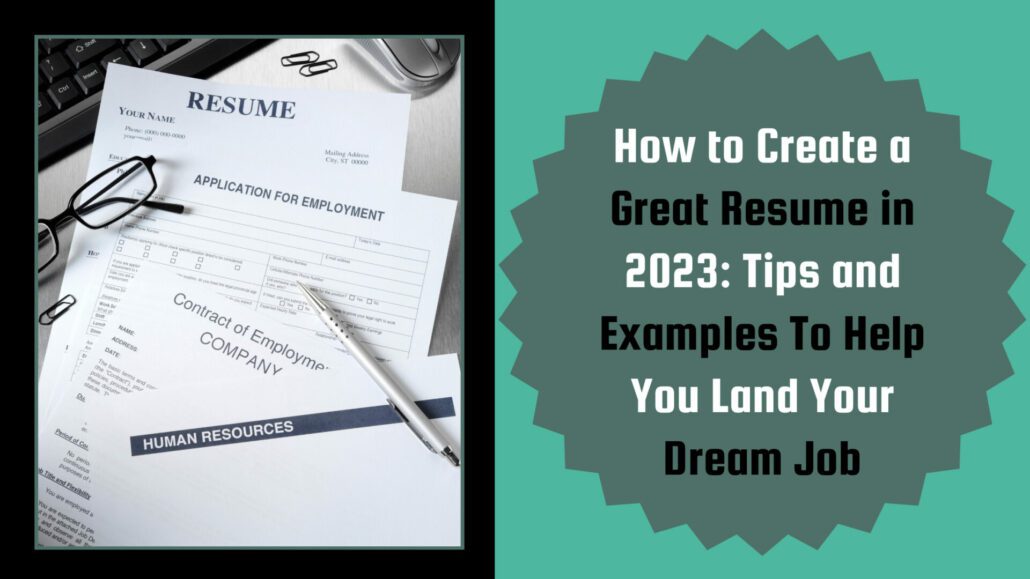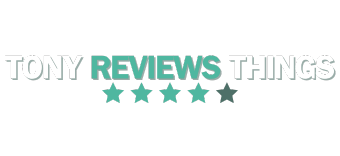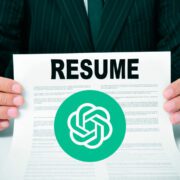How to Create a Great Resume in 2023: Tips and Examples To Help You Land Your Dream Job

So you want to create a great resume, but suddenly you realize – it’s no small feat. With so many details to consider and the pressure to stand out in the competitive job market, it’s no wonder many job seekers feel overwhelmed. Fear not! In this comprehensive guide, we’ll cover everything you need to know about crafting a top-notch resume, from formatting and design tips to highlighting your achievements and skills. We’ll also answer some common questions and offer some handy links along the way.
Let’s get after it!
How to Create a Great Resume: Resume Writing Techniques for Job Seekers
How to Format a Great Resume
Your resume’s readability and overall appeal heavily depend on the format you use. You should stick to a clean, easy-to-read layout with clearly defined sections, while also emphasizing important information using bullet points, boldface, and italics.
Resume Design Tips for Standing Out
A visually appealing resume can help you stand out from the competition. Use a professional font (more on this later), and consider adding a subtle pop of color to headings or your name. Keep it minimal and tasteful – less is more. Canva offers a variety of free resume templates to get you started.
How to Highlight Your Achievements on Your Resume
Rather than simply listing your job duties, focus on your accomplishments. Quantify your results whenever possible, and use action verbs to showcase your contributions. For example, instead of writing “Managed social media accounts,” try “Increased social media engagement by 25% through targeted campaigns.”
Skills to Include on Your Resume for the Job You Want
Carefully read the job description and identify the most relevant skills. Include a mix of hard skills (e.g., software proficiency) and soft skills (e.g., leadership, communication). Here’s a helpful list of skills to consider including on your resume.
Resume Examples for Different Industries
Different industries have unique expectations and preferences when it comes to resumes. Check out these resume examples for inspiration and guidance.
Common Mistakes to Avoid When Creating a Resume
Steer clear of spelling and grammar errors, unprofessional email addresses, and inconsistent formatting. Keep your resume concise and relevant – avoid filler words (we’ll discuss those later).
How to Tailor Your Resume to the Job You’re Applying For
Customize your resume for each job application by highlighting your most relevant experience and skills. Use keywords from the job posting to show you’re a perfect fit. This extra effort can make all the difference.
The Importance of a Great Cover Letter with Your Resume:
A well-crafted cover letter can boost your chances of landing an interview. It’s an opportunity to explain why you’re the ideal candidate and showcase your personality. Here’s a guide to writing a compelling cover letter. You may also want to consider asking ChatGPT to help you create a great resume – this is a chat bot’s dream task!
Answers to Common Resume Questions
How much job history should be on my resume?
If you’re going to create a great resume, it is important to include only the most relevant and recent work experience. Typically, it is recommended to include the past 10-15 years of work experience on your resume. However, if you have prior experience that is relevant to the job you are applying for, it is perfectly acceptable to include it on your resume.
The key is to focus on the most pertinent positions and achievements that demonstrate your skills and qualifications for the job you are applying for. This means tailoring your resume to each specific job application and highlighting the experiences that directly relate to the job requirements.
When including older work experience on your resume, be sure to keep the information concise and relevant. Avoid going into too much detail about positions that are not directly related to the job you are applying for. Instead, focus on the skills and achievements that are transferable to the current job.
When should you not put a job on your resume?
When it comes to crafting a strong and effective resume, it’s important to be strategic in the information that you include. While it may be tempting to list every job you’ve ever had, this approach can actually work against you if certain positions are irrelevant or potentially damaging to your job search.
One key consideration when deciding whether or not to include a job on your resume is its relevance to the position you are applying for. If a position you held in the past is not directly related to the skills or experience required for the job you’re seeking, it may be best to leave it off. This can help you create a great resume and make it easier for hiring managers to see how your experience aligns with the job requirements.
Another factor to consider is the length of time you spent in a particular role. If you only worked at a job for a few months or less, it may not be worth including on your resume. This can be especially true if the position was very different from the job you’re currently seeking, as it may not provide much relevant experience or insight into your capabilities.
Finally, it’s important to think about whether a particular job could create an unfavorable impression with potential employers. This could include positions where you were fired or had a negative experience, or jobs that are associated with a controversial or stigmatized industry. In these cases, it may be best to leave the position off your resume altogether in order to avoid any potential biases or negative perceptions.
What is the best font for a resume?
When it comes to choosing a font for any written material, it is important to consider factors such as readability, professionalism, and consistency – especially if you’re going to create a great resume. One way to ensure that your text is easily readable and appears professional is to choose a clean, legible font. Some of the most popular and widely used fonts for professional documents include Arial, Helvetica, Calibri, and Times New Roman.
Arial is a sans-serif font that is known for its simple and clean appearance. It is commonly used in business documents, presentations, and website designs. Helvetica is another sans-serif font that is similar to Arial in its simplicity and legibility. It is often used in advertising, branding, and print media.
Calibri is a newer font that was designed specifically for Microsoft Office. It has a modern and clean look that is easy on the eyes, making it a popular choice for business documents, resumes, and presentations. Times New Roman, on the other hand, is a classic serif font that has been used in print media for centuries. It is widely recognized as a professional font and is commonly used in academic papers, legal documents, and other formal documents.
When choosing a font size for your text, it is important to consider both readability and aesthetics. For body text, font sizes between 10 and 12 points are generally recommended. This is because smaller font sizes can be difficult to read, while larger font sizes can make your text appear too bulky. Slightly larger font sizes can be used for headings and subheadings to create visual hierarchy and make your document easier to scan and navigate.
What are filler words in a resume?
Filler words, also known as buzzwords or clichés, are common phrases that are often used in resumes with the intention of making the candidate sound more impressive or desirable to potential employers. However, these words are often vague and lack any real substance or meaning, and as a result, they do not add any real value to the resume.
Examples of filler words include phrases like “hard worker,” “team player,” “detail-oriented,” “self-starter,” “results-driven,” and “proactive.” While these words may sound impressive at first glance, they are so overused in resumes that they have become almost meaningless.
Instead of relying on filler words, candidates should focus on providing concrete examples of their skills and accomplishments. This means highlighting specific projects or tasks they have completed, quantifying their achievements with numbers or statistics, and using action verbs to describe their actions and accomplishments.
For example, instead of simply saying “detail-oriented,” a candidate might describe their experience creating and implementing a quality control system that reduced errors by 25%. Similarly, instead of using the phrase “team player,” a candidate might highlight their experience collaborating with cross-functional teams to complete a complex project under tight deadlines.
What skills should not be on a resume?
Creating a compelling resume requires a strategic approach to highlighting skills. You should avoid including every skill you have learned and focus on demonstrating specific qualifications that show your ability to excel in the position being hired for, as hiring managers seek these qualifications.
One common mistake job seekers make is including outdated or irrelevant skills. If you’re applying for a position that requires knowledge of the latest software or technology, listing proficiency in obsolete software will only serve to show that you’re out of touch with current industry trends. Similarly, if you’re applying for a job that requires advanced coding skills, listing proficiency in basic HTML is unlikely to impress the hiring manager.
You should avoid including skills that are expected or basic, such as Microsoft Word or email. Most applicants are expected to have these fundamental skills, so including them on your resume will add little value. Instead, you should focus on the skills that set you apart from other applicants and are most relevant to the position.
When deciding which skills to showcase on your resume, think about the specific requirements of the job and how your skills and experience align with them. If the job requires strong project management skills, highlight your experience leading complex projects and your ability to manage timelines and budgets. If the job requires excellent communication skills, emphasize your experience working with cross-functional teams and your ability to effectively communicate with stakeholders at all levels.
Wrapping up
In conclusion, you need to dedicate time and effort to create a great resume. It is worth it since it increases your chances of landing your dream job. By following these tips and examples, you will craft a standout resume that showcases your unique qualifications and helps you rise above the competition.
Good luck!
Tony has a bachelor’s degree from the University of Phoenix and over 11 years of writing experience between multiple publications in the tech, photography, lifestyle, and deal industries.





Leave a Reply
Want to join the discussion?Feel free to contribute!